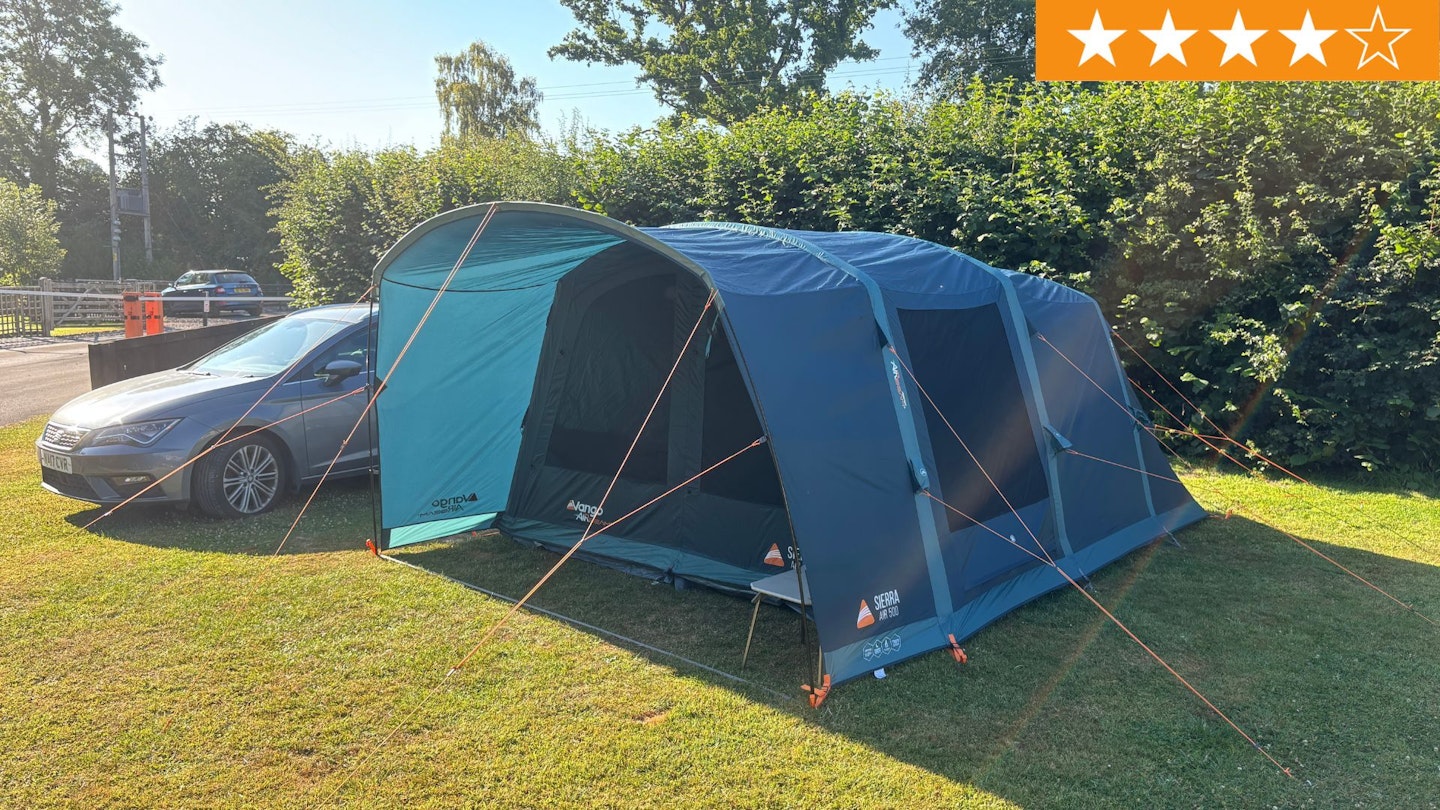Take yourself to any large campsite around the UK and you can pretty much guarantee there’ll be at least one inflatable tent pitched up somewhere.
They’ve become more and more popular over the years and it’s easy to see why. The best inflatable tents are simply easier to put up than many pole-based competitors, especially if someone is tackling the task on their own.
Vango is one of the main players in the market and the brand launched several new air tents in 2025, including the Sierra Air 500, which is what I’ve got on test here.
It’s a five-person tent (there’s a poled version, too) designed specifically with summer breaks in mind, so ventilation is very much a focus. In its sales copy, Vango also boasts about ‘excellent strength to weight’ and shouts about its ‘Midnight Bedrooms’, which are designed to help you sleep in longer.
Another big attention-grabbing feature is the porch canopy, which extends by 80cm beyond the zippered opening.
So, after several camping trips in the Sierra Air 500, would I recommend it to families or couples that like a lot of space? Let’s find out.
Pros
- Great ventilation for hot days
- Decent pack size and weight
- Easy to pitch and pack down
- Extended canopy is genuinely useful
Cons
- Living area feels small unless you pack lightly
- Only one way in
| RRP: | £660 |
| Weight: | 19.14kg |
| Packed size: | 80x38x38cm |
| Dimensions: | 325x460cm |
| Internal peak height: | 195cm |
Pitching
Starting with set-up, the Vango Sierra Air 500 proved intuitive to pitch. As with most inflatable tents, it was simply a case of pegging out the corners and porch, and then plug into each beam and inflate.
Those first six pegs come in the form of lengthy orange plastic ones. They’re chunky and robust, so you’d want a mallet to nail them into the ground, especially if the weather has been sunny for a while.
My testing took place with a handful of summer trips, during what is predicted to be one of the driest/warmest on record. Given that, and the hardness of the ground, I was impressed with the quality of these pegs. They made a valiant effort.
However, after the fifth trip, there were signs of wear. The tip of one peg bent and subsequently snapped off (though was still useable), while another also started to creak. I’m pretty confident that in most other summers this wouldn’t be as much of an issue, and I’m sure many other pegs have suffered a similar fate given the conditions.
The pump itself came included with the tent and was dual action, so it pushed air into the beams on both the upward and downward strokes. It also had a handy pressure gauge complete with a green zone to tell you when you were sorted.
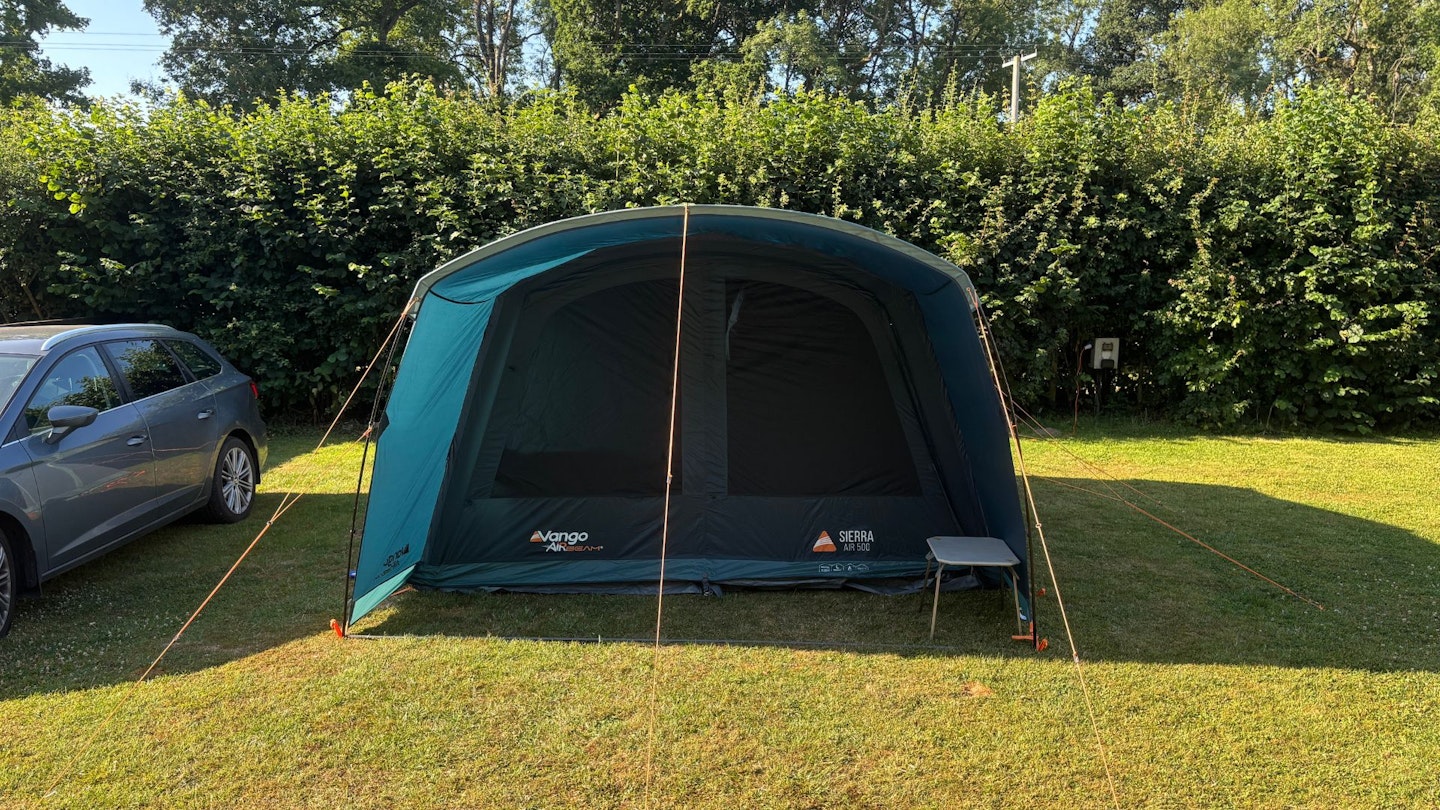
There are three beams in total to pump up, plus a metal pole to thread through the canopy on the porch.
On average it took me 10-15 minutes to remove the tent from my boot, unpack it, peg out the groundsheet, pump up the beams and thread through the porch pole, by which point the full structure was set up and ready to use.
I’ll point out that this was me pitching the tent on my own, so you can definitely cut down that time with one or more people helping.
It took me approximately 5-10 extra minutes to then finish pegging out the flysheet and guylines (depending on how focused I stayed), though again, this would be halved if someone else decided to help me!
That gives us a total pitching time (for one person) of around 20 minutes. With more haste and help, I reckon that could easily come down to less than 15 minutes, so not too bad at all.
Shape, structure and internal liveability
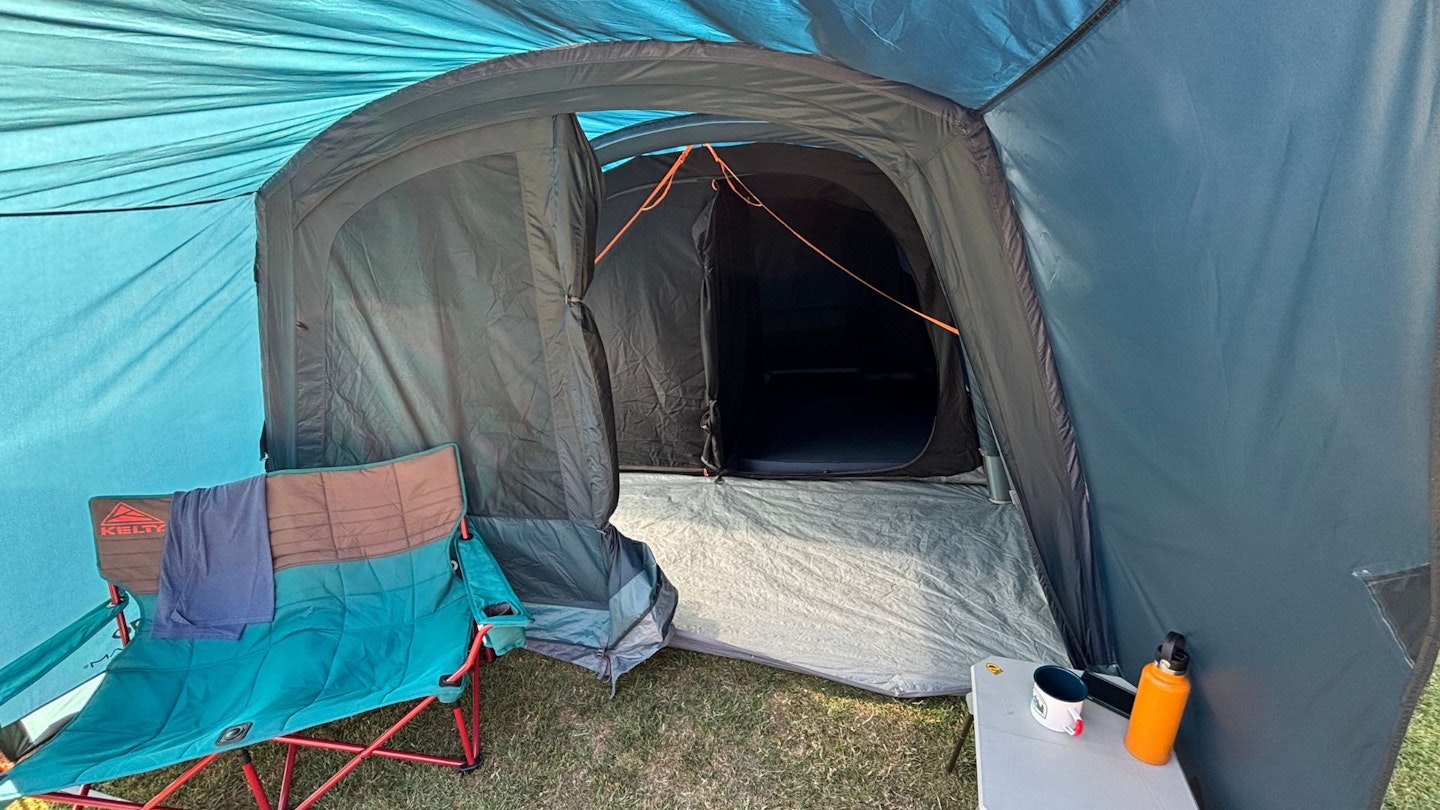
Once pitched, the Sierra Air 500 feels like a very solid tent. It’s not too troublesome to get the flysheet nice and taut, while the AirBeams feel strong. You get a lot of guy lines and pegging points to help with stability, which all works very well. Plus, you get plenty of pegs, which is always appreciated.
Inside, you get two bedrooms separated by a fabric divider, though you could remove this easily enough if you wanted to, as it’s only attached via toggles. This means there’s a gap around the edges of the divider, so expect small heads to pop around it if sharing the tent with kids.
With the divider in place, each bedroom will take a double bed with ease (and here's our pick of the best camping mattresses). You’ll be left with perhaps a foot or two of spare space across the width of the tent, but you certainly wouldn’t be able to squeeze in an additional sleeping mat, for example.
The official size of the bedroom compartment (as one) is 300cm by 210cm, so it’s long enough that most adults should be able to stretch out with ease.
Could you fit five adults side by side in here if you removed the divider? Probably, but you’d be shoulder-to-shoulder and it wouldn’t be much fun.
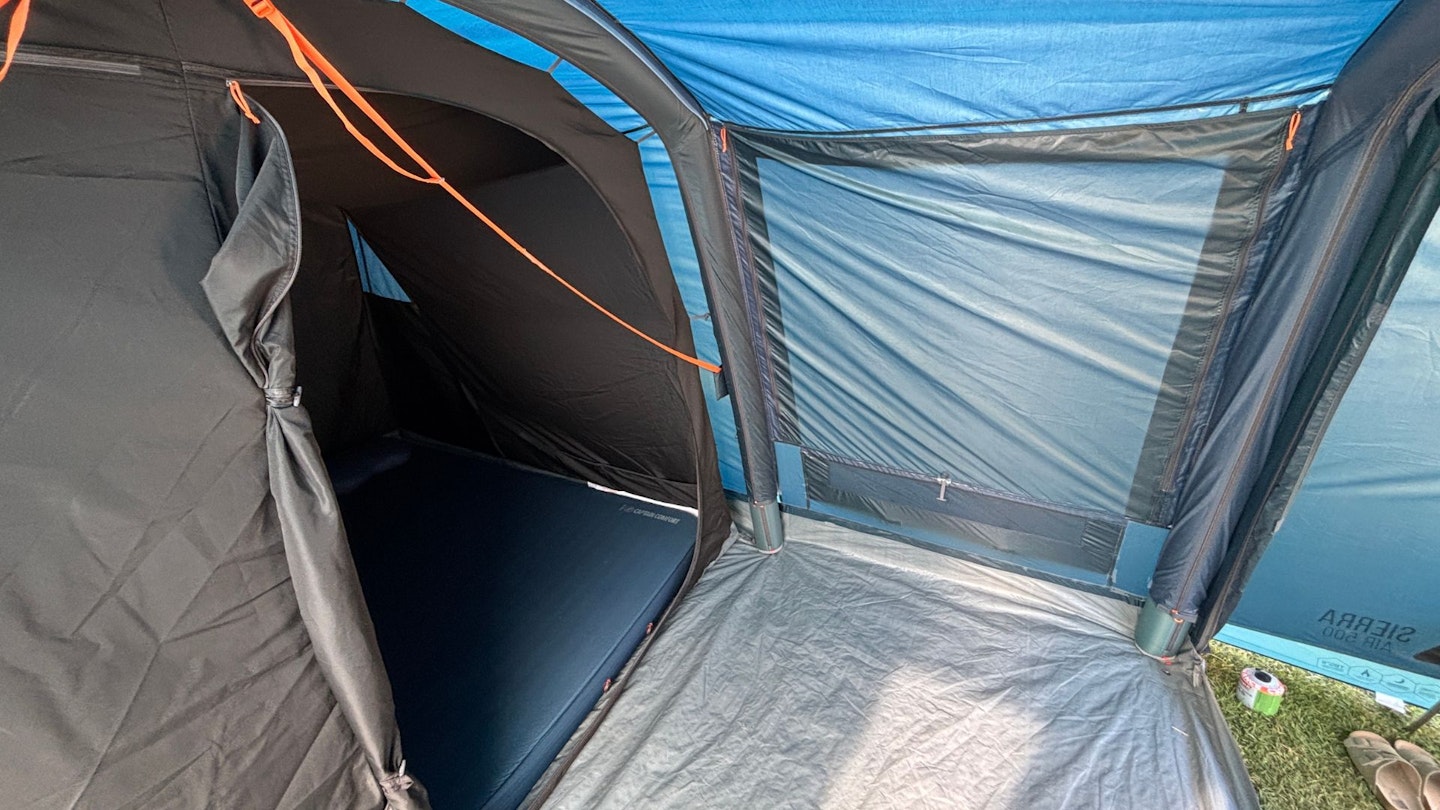
A family of five would make do, though again, there wouldn’t be a huge amount of wiggle room if the youngsters aren’t actually that young anymore. The bedroom is perfect for four people, though, even if it is four adults.
The living space is where I felt there was more of a problem, though. This internal area measures 300cm by 150cm, which is fine, and four people can easily sit in this space. However, if you have a camping fridge, some storage boxes, a camping table and a few camping chairs, it starts to get pretty congested.
That’s not such an issue if the weather is good, or even if there’s light rain, as you can open the main door all the way and spill out under the extended canopy. If you’re stuck with sideways or heavy rain all weekend, though, the porch extension won’t be a huge help and the living space isn’t not going to be the most enjoyable space to be, as you’ll likely feel a bit cramped.
Of course, you could opt for something bigger, either from Vango or a competitor. The Outwell Colorado 5 Air offers 260cm by 320cm of living space, for example, but it’s also around 7kg heavier and doesn’t pack down quite as small.
Ultimately, then, it’s a trade-off between internal living space, weight and pack size, as it usually is. If you don’t pack a lot of extras or have small children, you’ll have no issues with the living space, but if you’re an older family that overpacks, you may bemoan it on rainy days.
Weather protection

Considering summer 2025 was basically a scorcher for most of the time, it proved tricky to truly put this tent through its paces in sustained poor weather, but my rain dances did at least bring a few heavy downpours.
I was sceptical about how well the Sierra Air 500 would cope in heavy rain, given it’s designed for summer and prioritises ventilation, but it dealt with the downpours well, with most water streaming straight off the flysheet and down to the floor (though some remained on the roof).
The flysheet is made from Vango’s Sentinel Dynamic Weave 100 fabric, which has a 4,000mm hydrostatic head, utilises taped seams and has been weather tested to meet the EN ISO 5912 standard.
That said, one of my main concerns was the mesh window on one side. The mesh was on the outside and was backed by some waterproof material on the inside that could be zipped up (for weather protection) or down (for ventilation).
I wondered if this could be a weak point in wet weather, but it worked fine in my experience, though I wasn’t able to test it in a whole weekend of wet weather, for example.
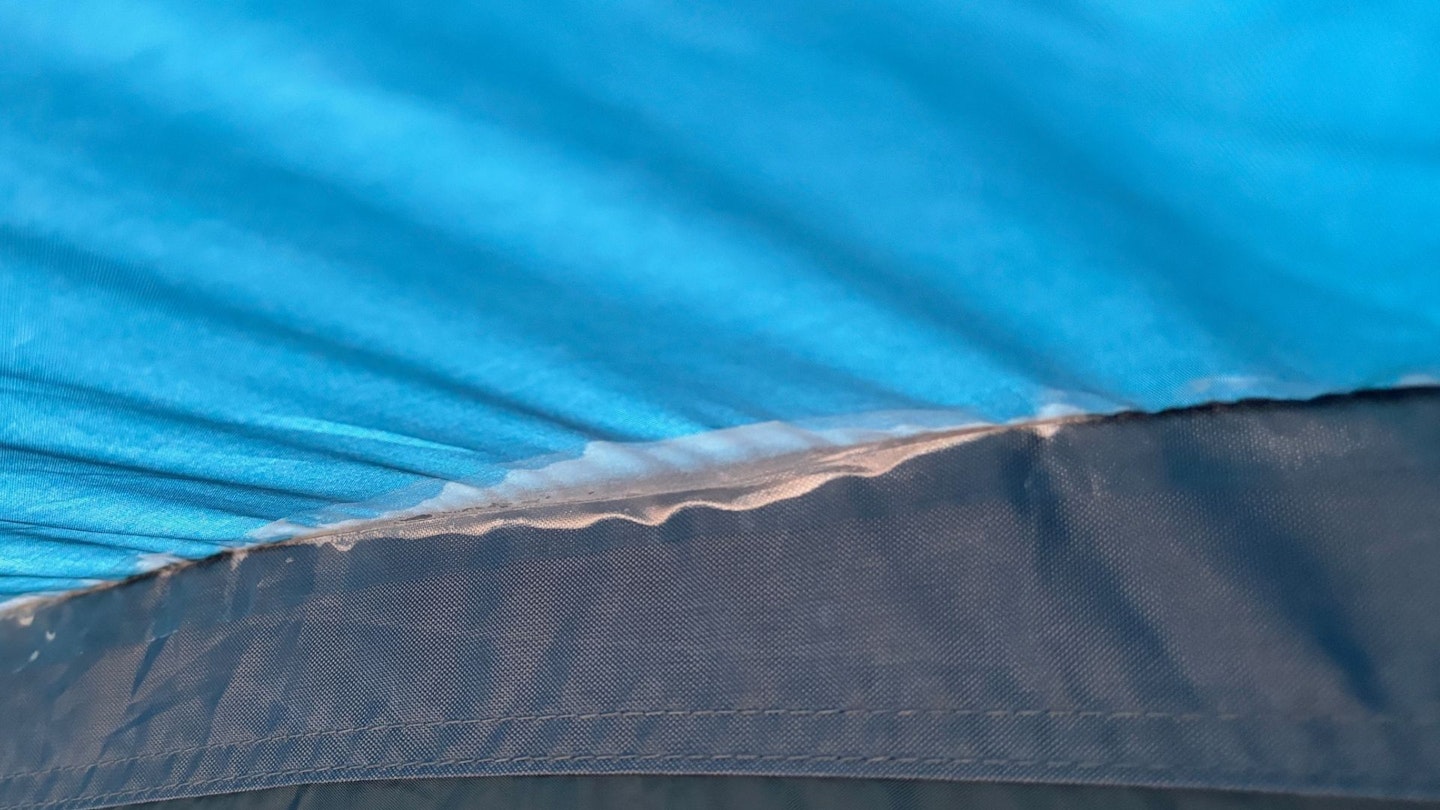
Another thing to note is that I did spot some signs of the seam tape pulling away from the tent fabric on the ceiling of the extended porch area (pictured above). There’s not been a complete separation yet and this may be an isolated incident related to the hot weather it’s been used in repeatedly.
I’ve also not seen any other reports of this in consumer reviews or in forums or Facebook groups, so it doesn’t seem to be a common issue.
Sadly, my camping trips with this tent weren’t blighted by strong winds for ideal testing, but there were some breezy spells and nothing suggested to me that this tent would be weaker than its competitors in this regard.
Sure, the extended canopy may catch the wind more than tents without this sort of feature, particularly if dealing with direct gusts, but the many guylines and strong beams gave me confidence.
There’s a TBSII Tension Band System (the orange straps that connect each sidewall with a centre point) that can be connected and tightened to help avoid sideways movement in poor weather, too.
Condensation
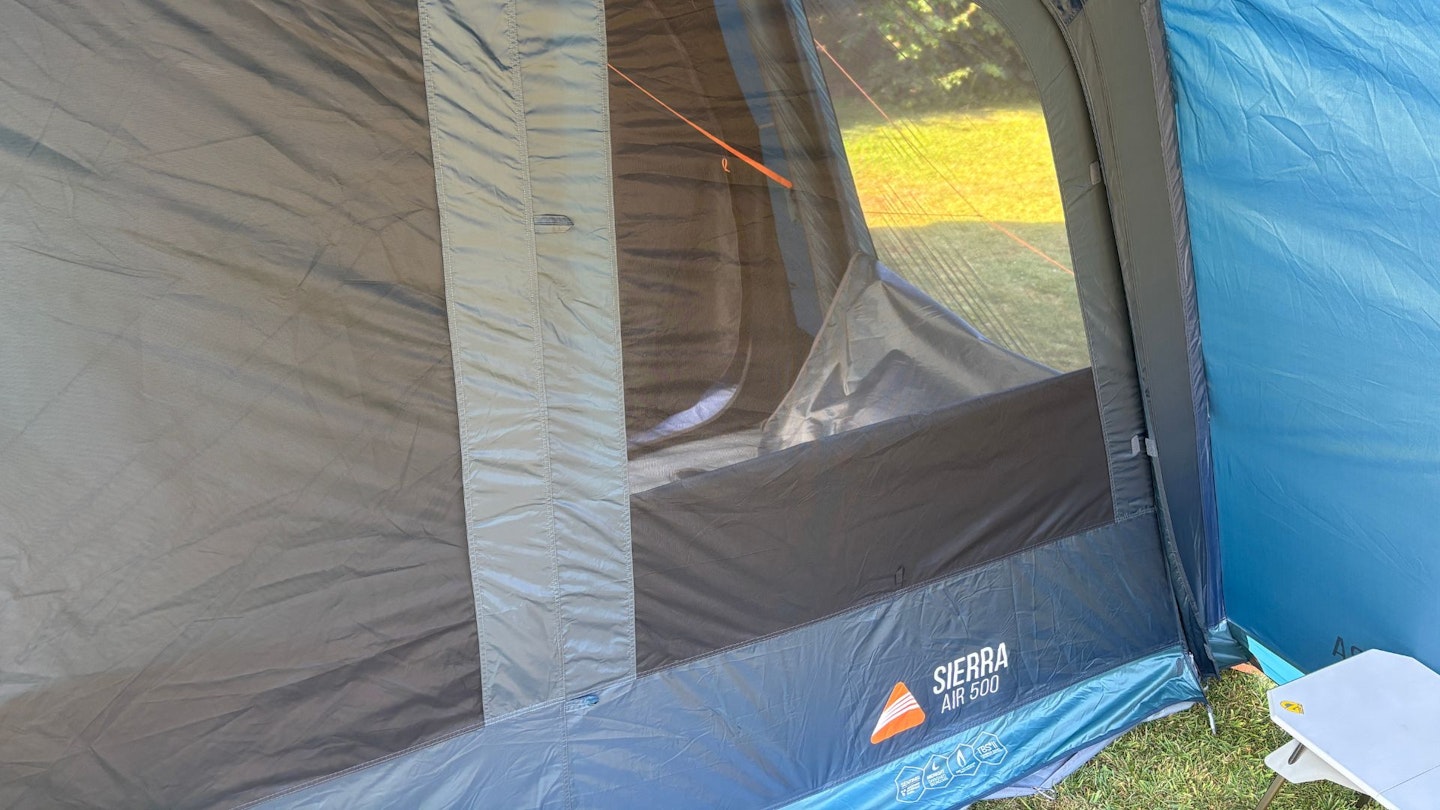
As mentioned already, this tent is very much aimed at spring and summer use, with ventilation a key consideration. As such, you get a small vent on either side of the living area, plus a large one at the rear of the bedroom.
You then also get a mesh window (with a waterproof backer that can be zipped up in bad weather), plus the option to open up two large mesh panels on the front door.
That’s a lot of ventilation and with that all open condensation should very much be under control.
The only issue is, if the weather is poor or it’s a chilly night, you probably won’t want those all undone. With the doors and side mesh window covered up, we did notice some condensation on the roof of the tent (after four people slept in it).
Admittedly, though, I’d say that’s par for the course in such scenarios, and you’ll be hard pushed to find a tent that’ll stay completely dry.
Weight and pack size
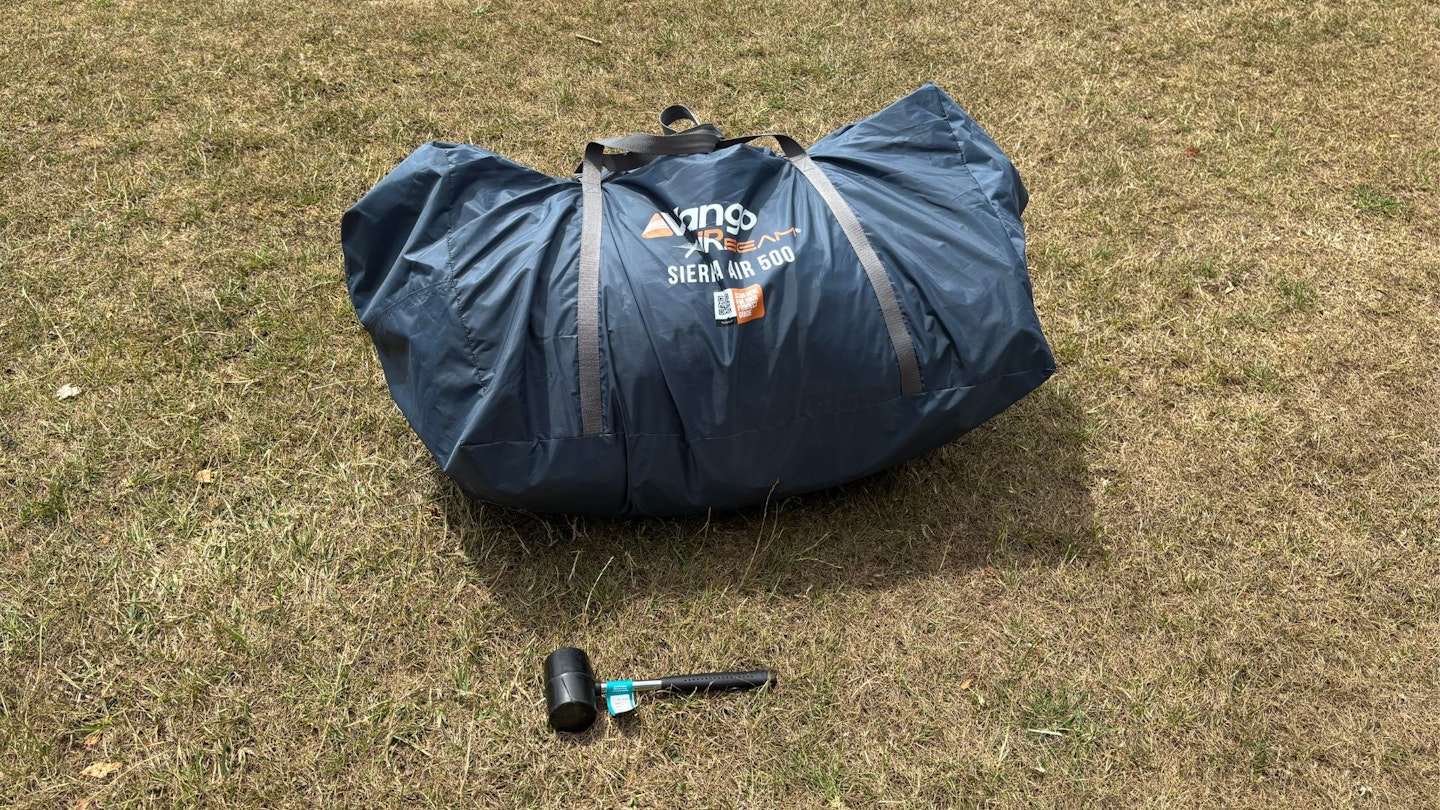
Tents of this size rarely pack down small and, while that’s the case here, I was pretty pleased with the pack size.
Packing down took a similar amount of time to pitching and wasn’t too taxing, though it’s often a bit of a faff to roll up and pack away the tent, no matter what one you have.
The good news here, though, is that the storage bag is large enough that you’re never faced with a tough wrestle.
I’d say a weight of 19.14kg is also reasonable for what you’re getting here. Sure, you can get lighter tents, but there are also a lot of heavier ones, so this is a happy middle ground.
I was able to lug it around myself without too much of a struggle, while the bag’s carry straps make it straightforward for two people to carry it together, too.
Features
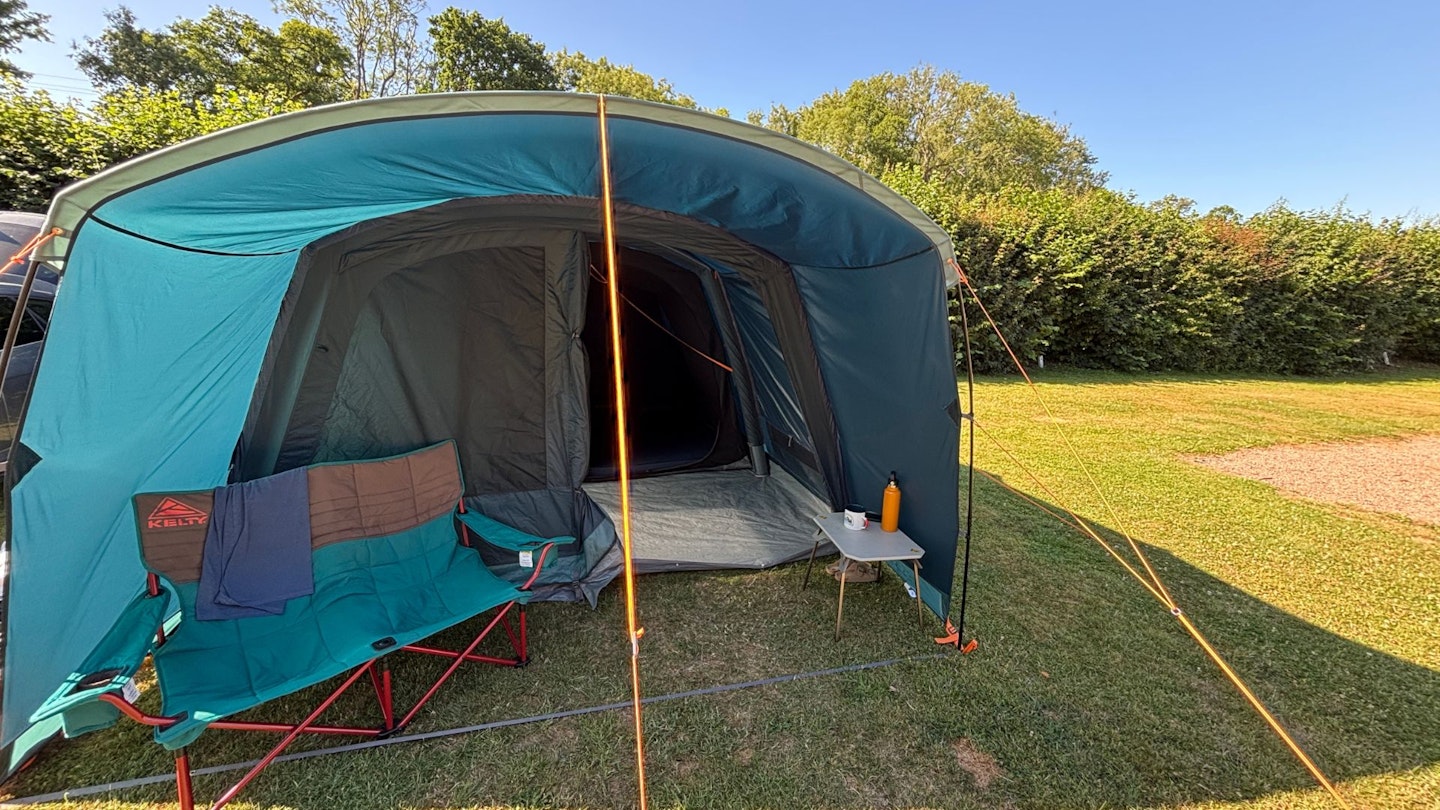
Admittedly, we’ve covered a lot of the features (e.g. vents, windows, tensioning system) already in the rest of this review, but there are some other things that need commenting on.
You only get one main entrance, as there’s no side opening like you get with some other tents. That one big door stretches across the front of the tent and can be rolled back and secured at the halfway point or opened fully and secured to the left-hand side.
This really helps keep things cool on a hot day, while the extended porch canopy gives you extra cover. The latter is also very useful if you’re trying to kick off your walking boots and get into the tent when it’s raining, but don’t want the inside to get soaked.
Back to the door, though, which only unzips from one corner. This can make it awkward to access if you’ve got kit stored along that side of the tent. An alternative entrance would have been helpful.
There’s also no zip at the bottom of the door, so you’re only able to fasten it up via toggles. This means it’s not completely insect proof (though we had no issues or infestations during our tests) and also raises question marks about whether or not torrential sideways rain would sneak inside. But again, we didn’t have any weather like this during testing.
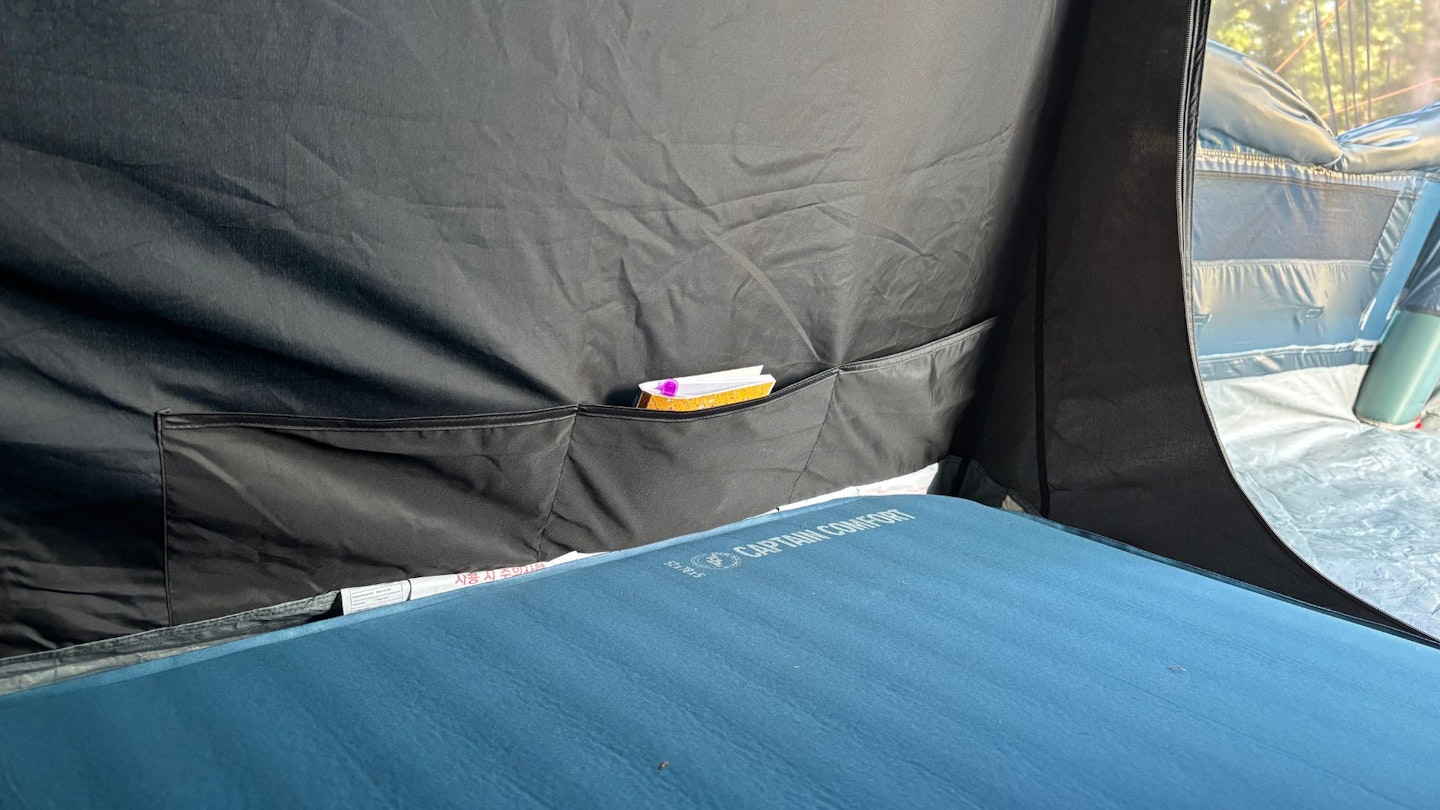
The other thing I think this tent lacks is storage in the living area. There are no pockets to stash anything, and only a couple of loops to hang stuff from.
Now, this tent does have Vango’s SkyTrack II tech, which is a flexible hanging system, however, you’ll need to buy ‘Sky Hooks’ to be able to use it, which you can then hang stuff from (including storage pouches sold by Vango). It’s a shame none of this is included as standard, though.
Storage is better in the bedrooms, though, as you get three pockets in each one that's handy for things like head torches (pictured above). The other handy feature here is the darkened fabric on the bedrooms. It works reasonably well and definitely reduces the light coming in (especially around dawn and dusk or on cloudy days), but if you’ve got direct sunlight beating down on the tent then it still feels pretty light.
Oh, and you also get a zipped entry point for electric hook-up on the left-hand side.
Verdict
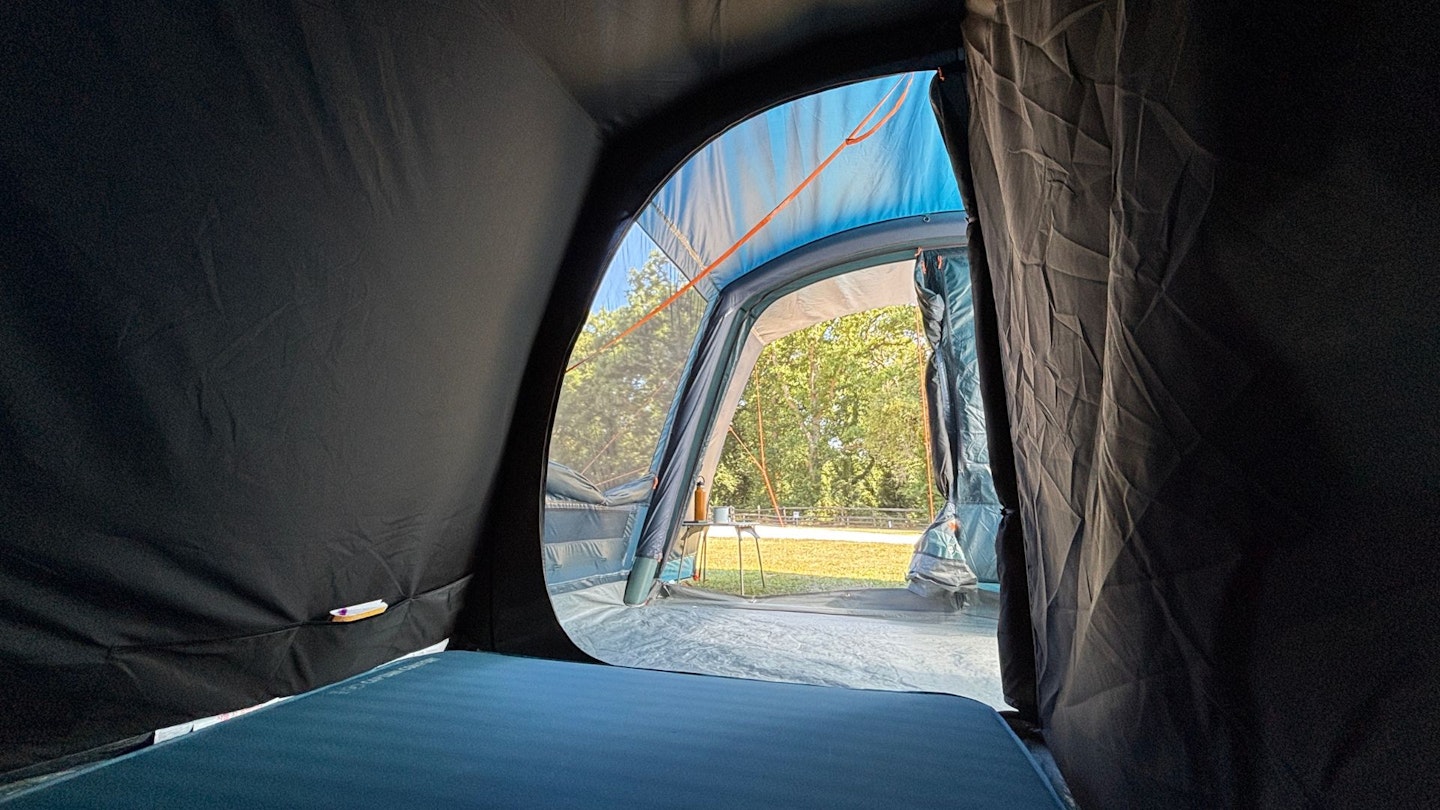
This is a great tent for the warmer months. It’s not perfect and there are certain caveats that come with it, but I think it hits a nice balance of features, pack size, weight and liveability.
It works for a family of four, as long as you don’t want to take a lot of extra kit or sit around a big table, while it’s easy to pitch and put away.
For a mix of alternative options, see our list of the best family tents, which covers both inflatable and poled tents.
About the author

Rob Slade is deputy editor at LFTO and has a long history of camping, hiking and reviewing gear. He previously worked as content editor at 220 Triathlon and, before that, editor at Adventure Travel magazine (which is now called Wired For Adventure). He's camped all over the world, including New Zealand, Jordan and across the UK.
